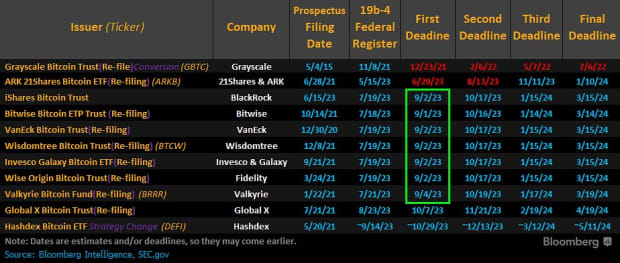The long-awaited recession and ensuing resumption of the 2022 bear market that many have been anticipating have did not materialize up to now in 2023. In actual fact, most belongings have caught a bid, with the Nasdaq hitting a 52-week excessive on July 12.
How can this be, and can the rally proceed?
Michael Burry of The Huge Brief fame declared in January that america might be in recession by late 2023, with the Shopper Value Index (CPI) decrease and the Federal Reserve slicing charges (word that final week’s CPI print got here in a lot decrease than anticipated, additional fueling the current rally). This may result in one other inflation spike, in his view.

Just lately, impartial macro and crypto analyst Lyn Alden explored the subject in a publication printed this month.
Within the report, Alden examines in the present day’s inflationary setting by contrasting it to 2 related however completely different durations: the Forties and the Nineteen Seventies. From this, she concludes that the U.S. financial system will possible stall or expertise a light recession whereas experiencing some degree of persistent inflation. This might imply that markets proceed trending upward till an official recession hits.
My July 2023 publication is out:https://t.co/gTH0nUyrU8
The subject concentrate on fiscal dominance, and the way giant money owed and deficits can mute the affect of upper rates of interest as a coverage software. pic.twitter.com/qmuzInyYjK
— Lyn Alden (@LynAldenContact) July 2, 2023
The Fed’s inflation battle continues
The essential distinction between the 2 durations entails fast financial institution lending and huge monetized fiscal deficits, which Alden suggests are the underlying components driving inflation. The previous occurred within the Nineteen Seventies as child boomers started shopping for homes, whereas the latter occurred throughout World Conflict II on account of funding the struggle effort.
The 2020s are extra just like the Forties than the Nineteen Seventies, but the Fed is operating the Nineteen Seventies financial coverage playbook. This might develop into fairly counterproductive. As Alden explains:
“In order the Federal Reserve raises charges, federal curiosity expense will increase, and the federal deficit widens paradoxically at a time when deficits have been the first reason for inflation within the first place. It dangers being akin to attempting to place out a kitchen grease hearth with water, which makes intuitive sense however doesn’t work as anticipated.”
In different phrases, in the present day’s inflation has been primarily pushed by the creation of latest federal debt, or what some could name authorities cash printing.
Elevating rates of interest to calm inflation can work, however it’s meant for inflation that has its roots in an growth of credit score tied to banking loans. Whereas greater charges tame such inflation by making borrowing costlier and thus decreasing mortgage creation within the personal sector, they make fiscal deficits worse by rising the quantity of curiosity owed on these money owed. The federal debt in the present day is over 100% of gross home product (GDP), in comparison with simply 30% within the Nineteen Seventies.

Whereas the Federal Reserve has cooled some elements of the financial system by elevating charges by 500 foundation factors in little greater than a 12 months, the underlying trigger of the present inflationary setting stays unaddressed. And with a a lot greater debt-to-GDP ratio than the U.S. had 50 years in the past, the scenario will solely worsen at a quicker tempo. However markets have remained resilient, together with tech equities and crypto, though the correlation between the 2 has damaged.
On this manner, the Fed could also be utilizing a software unfit for the scenario, however this hasn’t stopped markets, at the least for now.
Huge Tech defies recession estimates and propels equities
Regardless of the Fed’s battle with inflation and market contributors’ expectation of an unavoidable recession, the primary half of 2023 has been fairly bullish for equities, with the rally extending into July. Whereas bonds have bought off once more, elevating yields to close 2022 highs, danger belongings like tech shares have been hovering.
It’s essential to notice that this rally has primarily been led by simply seven shares, together with names like Nvidia, Apple, Amazon and Google. These equities make up a disproportionate weight of the Nasdaq:
Simply seven shares make up 55% of the NASDAQ 100 and 27% of the S&P 500
The distribution has grow to be so lopsided that the NASDAQ shall be rebalancing to present these megacaps much less weight.
Supply: @GoldmanSachs pic.twitter.com/k1xM1wmL2S
— Markets & Mayhem (@Mayhem4Markets) July 13, 2023
Associated: Bitcoin mining shares outperform BTC in 2023, however on-chain information factors to a possible stall
Bonds down, crypto and tech up
The rally in tech due largely to synthetic intelligence-driven hype and a handful of mega-cap shares has additionally caught a tailwind from an easing in bond market liquidity.
Alden notes how this started late final 12 months:
“However then some issues started to alter at the beginning of This autumn 2022. The U.S. Treasury started dumping liquidity again into the market and offsetting the Fed’s quantitative tightening, and the greenback index declined. The S&P 500 discovered a backside and started stabilizing. The liquidity in sovereign bond markets started easing. Varied liquidity-driven belongings like bitcoin turned again up.”
A July 11 report from Pantera Capital makes related observations, noting that actual rates of interest even have a really completely different story to inform when in comparison with the Nineteen Seventies.
“The normal markets could wrestle — and blockchain may be a protected haven,” partially as a result of “[t]he Fed must proceed to lift charges,” provided that actual charges stay at adverse 0.35%, based on the report. The report additionally concludes from this, “There’s nonetheless tons of danger in bonds.”
The report goes on to notice that whereas most different asset lessons are delicate to rates of interest, crypto isn’t. Bitcoin’s correlation to equities throughout 2022 was pushed by the collapse of “over-leveraged centralized entities.” In the present day, that correlation has reached near-zero ranges:

Among the many key takeaways could also be that danger belongings seem to have a bid underneath them in the interim. Nonetheless, this development might simply reverse by year-end.
Dan Morehead of Pantera Capital stated it effectively when stating that:
“Having traded 35 years of market cycles, I’ve discovered there’s simply so lengthy markets will be down. Solely a lot ache traders can take. […] It’s been a full 12 months since TerraLUNA/SBF/and so on. It’s been sufficient time. We will rally now.”

With the halving proper across the nook and the prospect of a spot Bitcoin exchange-traded fund on the horizon, the catalysts for crypto appear poised for a breakout in nearly any scenario.
This text doesn’t include funding recommendation or suggestions. Each funding and buying and selling transfer entails danger, and readers ought to conduct their very own analysis when making a choice.









![Methods to Purchase DeFi Pulse Index on CoinStats [The Ultimate Guide 2022]](https://bitrrency.com/wp-content/uploads/2022/05/DeFi_Pulse_og-100x70.png)

